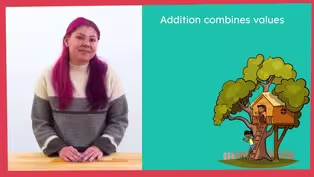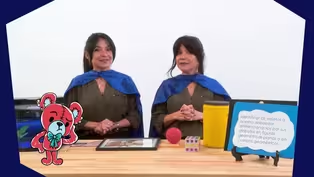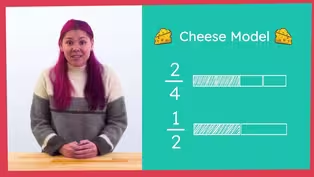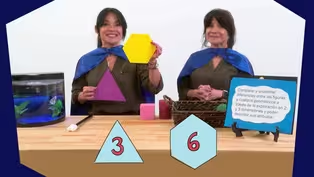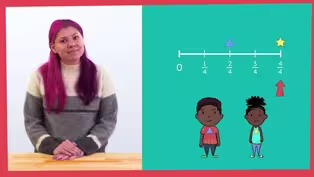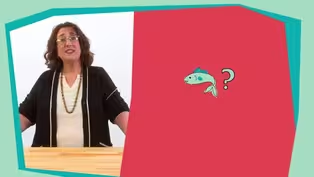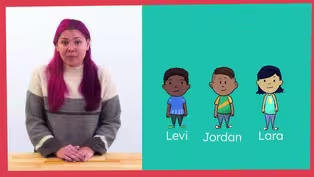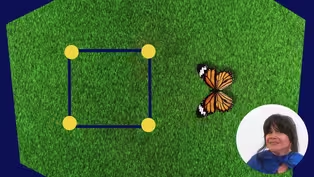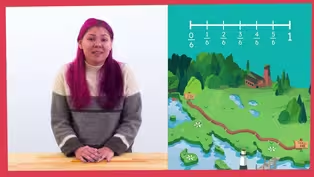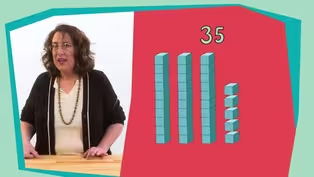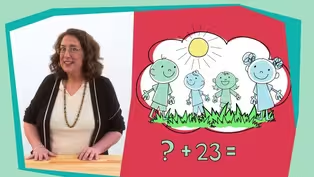
Episode 22 | Math Lessons
4/5/2021 | 28m 46sVideo has Closed Captions
Math lessons for early learners, led by NC teachers.
The first lesson (aimed at 3rd graders) helps students add and subtract whole numbers up to and including 1,000. The second lesson (aimed at 1st-2nd graders) helps early learners understand the relationship between addition and subtraction. Classroom Connection is your At-Home Learning companion where children love to learn. All lessons are led by NC educators.
Problems playing video? | Closed Captioning Feedback
Problems playing video? | Closed Captioning Feedback
At-Home Learning Presents: Classroom Connection is a local public television program presented by PBS NC

Episode 22 | Math Lessons
4/5/2021 | 28m 46sVideo has Closed Captions
The first lesson (aimed at 3rd graders) helps students add and subtract whole numbers up to and including 1,000. The second lesson (aimed at 1st-2nd graders) helps early learners understand the relationship between addition and subtraction. Classroom Connection is your At-Home Learning companion where children love to learn. All lessons are led by NC educators.
Problems playing video? | Closed Captioning Feedback
How to Watch At-Home Learning Presents: Classroom Connection
At-Home Learning Presents: Classroom Connection is available to stream on pbs.org and the free PBS App, available on iPhone, Apple TV, Android TV, Android smartphones, Amazon Fire TV, Amazon Fire Tablet, Roku, Samsung Smart TV, and Vizio.
Providing Support for PBS.org
Learn Moreabout PBS online sponsorshipMore from This Collection
Math lessons for early learners, led by NC teachers.
Video has Closed Captions
Math lessons for early learners, led by NC teachers. (28m 46s)
Video has Closed Captions
Math lessons for early learners, led by NC teachers. (28m 46s)
Video has Closed Captions
Math lessons for early learners, led by NC teachers. (28m 46s)
Video has Closed Captions
Math lessons for early learners, led by NC teachers. (28m 46s)
Video has Closed Captions
Math lessons for early learners, led by NC teachers. (28m 46s)
Video has Closed Captions
Math lessons for early learners, led by NC teachers. (28m 46s)
Video has Closed Captions
Math lessons for early learners, led by NC teachers. (28m 46s)
Video has Closed Captions
Math lessons for early learners, led by NC teachers. (28m 46s)
Video has Closed Captions
Math lessons for early learners, led by NC teachers. (28m 45s)
Video has Closed Captions
Math lessons for early learners, led by NC teachers. (28m 46s)
Video has Closed Captions
Math lessons for early learners, led by NC teachers. (28m 45s)
Video has Closed Captions
Math lessons for early learners, led by NC teachers. (28m 46s)
Providing Support for PBS.org
Learn Moreabout PBS online sponsorship[cheerful upbeat music] ♪ - Hey, everyone, I'm really glad you're here today because I need your help.
I'm trying to write this song, but I keep getting stuck.
Here, let me show you, here it goes, ♪ one, two, three, four, ♪ ♪ put on my shoes and walk out the door.
♪ ♪ I say, five, six, seven, eight, ♪ ♪ the sun is shining and I'm feeling, fine?
♪ That doesn't rhyme, hold on, hold on, hold on.
♪ Five, six, seven, eight ♪ ♪ The sun is shining and I'm feeling, good.
♪ No, no, that's not right, either, aargh.
Now what's a word that rhymes with eight, and means super good?
[bright upbeat music] Wait, hold on, I think I heard something.
Now say that again.
Great, yes, that's it.
♪ Five, six, seven, eight, ♪ ♪ the sun is shining, and I'm feeling great.
♪ Wow, thank goodness, you're here.
I would have never finished that song.
Looks like I could use some more practices with my reading and my numbers.
You wanna practice too?
Okay, let's do it together, starting now.
[bright upbeat] - Hello, friends, Diane here, it's great to see you.
Today, we're going to talk about strategies for adding numbers.
I have a problem that I could really use your help with?
I'm planning a road trip and wanna keep up with how far I have to drive from one place to another.
Can you help me?
Awesome, do you think you can work through a problem now?
I'd really like to hear how you solve my road trip problems.
I have a feeling that we may use a number line to help us represent the problem.
Before we get started, let's review what we know about number lines.
Let's use a frayer model to help us.
Are you ready?
Let's get started.
To make our frayer model, you will need a piece of paper, a pen, a pencil or a marker.
I'm going to get my supplies, you go ahead and do the same.
[bright upbeat music] Now that we have our supplies, let's begin to make our frayer model.
Let's take a piece of paper and fold it in half hamburger style.
Then, we're going to fold it in half again, to make four equal rectangles.
[bright upbeat music] Now, in the corner of our paper where all sides are folded, we'll fold it down to make a small triangle.
When you unfold your paper, the folds should look like this.
Does yours look like mine?
Okay, great.
So now we're going to write the word number line in the center diamond, because this is the word we need to understand more about.
[bright upbeat music] Then, in the upper left rectangle, we're going to define this term.
So let's write the word definition here.
[bright upbeat music] In the upper right rectangle, we're going to provide an example of number lines.
So let's write example here.
[bright upbeat music] Then, in the lower left rectangle we'll provide a non-example or what number lines are not so write non-example here.
[bright upbeat music] And finally, in the lower right rectangle, we'll draw a picture to help us visualize what number lines are.
So, let's write the word picture here, to remind us of what we're supposed to do.
[bright upbeat music] So a number line is a line with numbers placed in their correct position.
Number lines are useful for adding and subtracting, and for showing relations between numbers.
I'm going to give you some time to write these definitions in your frayer model.
[bright upbeat music] As we use number lines to help us think through the math in today's lesson, you will be able to add examples, non-examples, and draw a picture to share your growing understanding.
On Monday, I will leave home drive 158 miles and then stop and eat lunch.
After lunch, I'll drive 36 more miles to get to my destination.
How many miles will I drive altogether?
Does this problem make sense to you?
Try to tell it in your own words to someone at home, and could you tell it to me too?
Okay, great.
Did that help?
I know that I will be leaving home and driving 158 miles and then stopping.
And then I'll drive 36 more.
So I need to find the total number of miles on day one.
Retelling with words helps me understand the problem.
But I can also use other ways to represent the problem.
Have you ever used a number line?
A number line makes sense to me too, because it reminds me of the road that we're traveling on in our story.
What numbers should we put on our number line?
Where will my road trip start?
At home.
I haven't moved yet, so I'll represent my starting point with the number zero.
Next, how far will I travel?
Exactly.
I'm gonna go 158 miles, then I'll stop and eat lunch.
So add 158 to my number line.
Then I'll go 36 more before stopping for the night.
How could we represent what is happening in our story, and on our number line with an equation?
[bright upbeat music] Did you say 158 plus 36?
Very nice.
We're adding a distance of 158 miles to 36 more miles to get the total number of miles that I would travel on Monday.
Before we start solving, it's a good idea to estimate our answer.
That way we'll know if our solution is reasonable or not.
If I'm thinking about the nearest 10, I know that 158 is close to 160, and 36 is close to 40.
So I know 60 plus 40 equals 100.
So if I add 100 plus 100, my estimate is about 200 miles.
Now it's time to find the solution.
I'll give you a moment to try and solve it at home.
You can explain your thinking with drawings, numbers, or words.
[bright upbeat music] Are you ready to share?
Can you show me what you did?
Wow, those are great strategies.
Can I share some of them?
Thank you so much.
Some of you use the expanded form, then added the numbers and parts.
So we had 158 plus 36.
So 158 can be decomposed into 100 plus 50, plus eight, and 36 can be decomposed into 30 plus six.
When we add each place value together, we get 100 for the hundreds place, 50 plus 30 equals 80 for the tens place, and eight plus six equals 14 for the ones.
So, we can add each of them together to get 100 plus 80 equals 180, and then 180 plus 14 equals 194.
Is 194 a reasonable solution?
Yes, it is close to our 200 mile estimate.
Let me share another one of our strategies.
Some of you use the number line like the one we use to represent the problem.
Let me see if I can share your strategy.
So remember this, you already know how far the first part of my road trip will be.
We'll start at home, which is zero, and we'll travel 158 miles.
Now we're going to add 36 to the 158 by decomposing or breaking apart the 36 and two parts.
I saw that some of you did it this way, 10 plus 10 plus 10, plus one, plus one, plus one, plus one, plus one, plus one.
On the number line, it will look like this.
[instrumental music] Adding this way, also gives us the solution of 194 miles.
Some of you also added on the number line, but decomposed 36 a different way.
Let's see how that would look.
This time 36 is decomposed into 30 plus three plus three.
Was our solution the same as the first?
Yes.
Was our solution close to our estimate?
Also, yes.
194 is close to 200, so we know our answer is reasonable.
And because we got the same answer using different strategies, we can be pretty confident that it's also accurate.
Are there other ways you could add 158 and 36?
What do you think?
Absolutely, there are a lot of different strategies to add numbers, and you showed me several of them.
Great job today mathematicians.
Before we go, let's recap what we did today.
We took a moment to retell or summarize our story problems to make sure it made sense.
Then we represented it with a number line and an equation.
Before solving we estimated the answer so that we would know if our solution was reasonable.
Finally, we solved it with several decomposing strategies.
Fantastic thinking today.
I can't wait for us to work together again, and explore more math strategies.
Until next time, bye, y'all.
- That was a lot of work on my brain.
But I feel good now like my brain just ran a mile.
Well, we got more fun in store for today, but I'm excited to share with you.
So don't go anywhere.
- We're in this area, sort of in the central part of Utah.
And the reason we're here is there's a very thin narrow strip of rocks that are about 98 million years old.
And it's the time period we don't know anything about the dinosaurs that we're living here, so we came out here specifically just to excavate and prospect that little thin area of rock.
- Yeah, this is one of my favorite places to come.
Utah is an absolutely beautiful state.
And all throughout there are sites that you can go and dig for dinosaurs, for other fossils.
It's one of the best places in the world to come for fossils.
- So day one, we haul a lot of gear out to the site.
We haul picks and shovels and it's amazing.
In paleontology, we use a range from a dental pick all the way up to a 60 pound jackhammer.
And sometimes we flip between those pretty rapidly.
So we'll be jack hammering for a day we'll take off all the overburden, we'll be crack hammering with giant chisels, we'll find a bone everybody slows down.
- We use smaller hammers, we use finer chisels to move rock that's close to the bone so that we can see what's actually in the quarry itself.
And we don't wanna use a big axe, right next to the actual fossil because you don't wanna damage anything.
- So we think of fossils as data.
They're not just pretty things to look at, where they came out of the ground is very important.
Because it can tell you a lot about the animal, how it died, what kind of environment it was in.
- You're looking for the story behind the bones.
And a large part of that story comes from the geology.
So we go to a site, we find the bones, we see what kind of sediment it's in, is it a lake, is it an ocean, was it deposited in a river, very far away from a river, - what part of the skeleton it's from, whether it's a vertebra, whether it's a limb bone, whether it's a claw or toe bone.
When we're getting a specimen ready for transport, we can't just take it out of the ground and put it in a truck and bring it back because it's too fragile.
We uncover the surface of the bone and leave it in the ground, we don't take it out of the ground right away.
- And then we'll mix up some plaster in water and cut and burlap strips, we'll dunk those in and cover that whole specimen encased in rock and plaster we'll undercut it and flip it over and jack it the other side and it's all ready to go back.
Once we excavate things, and we wrap them in plaster and burlap jackets, we then have to haul them all the way back to the vehicles, - We will strap it down with ratchet straps down to a Blackboard or a sled and get a bunch of people around it and carry it together in unison back to camp.
- We have a really heavy jacket and we can't drive up to the location.
There's only one way to get it out of there, and that's using a helicopter lift and that can get pretty expensive too.
[helicopter engine roaring] - Hi friends, my name is Dawn, and I am so happy to be here with you today.
And I brought my friend along, Splat.
Before we get started, you might want to get a trusted adult or stuffed animal to talk about your math thinking.
You might want to get some beans or pasta to help you make the different numbers we see today.
Finally, you might want to get some paper and a pencil so you can write about your math learning at the end of our time together.
I'll wait while you get what you need.
[bright upbeat music] Welcome back, I hope you have all that you need.
We are going to have some fun with subitizing today.
Subitizing is quickly seeing how many items are present such as dots.
Splat wanted to join us today and learn about a really awesome tool we are going to use called a five frame.
This will help us organize our thinking when we see dots.
We're going to show you some dots in the five frames very quickly.
Your job is to say or show how many dots you see with each picture that flashes on our screen.
Then you get to explain out loud to an adult or stuffed animal, how you see the dots.
Splat isn't really sure how this will all work, so we are going to help him out.
Are you ready?
Let's go, watch the screen.
[bright upbeat music] Wow, that was super quick.
Say out loud or make with your beans or pasta, how many dots you saw.
[bright upbeat music] Did you hear that Splat?
They saw seven.
That's right.
How did you see the seven dots?
Will you say that out loud so Splat can hear how your brain saw those dots?
Or you can make the dots with the beans or pasta.
[bright upbeat music] My brain saw four dots on top, and three dots on bottom.
And I know that if I move one dot to the top, that makes five, and that five plus two equals seven.
I wonder how many dots I need to make both five frames full.
Can you whisper to yourself or use your beans or pasta to show how many dots I have to add to make all of my squares full?
[guitar music] That's right, I need three dots and both five frames would be full.
That would make a 10.
We know this because three plus seven equals 10.
You worked so hard on this.
Let's do another one.
Watch the screen.
[guitar music] That was super quick again.
Tell an adult or stuffed animal out loud, so Splat can hear you, how many dots you saw on the screen.
[guitar music] You saw eight dots?
We did too.
Now tell Splat how you saw the dots.
Or you can make the picture of dots with your beans or pasta.
[guitar music] My brain saw the two empty squares, and I know that two less than 10 is eight.
So I knew there were eight squares because 10 minus two equals eight.
Splat whispered to me that he saw four dots on top and four dots on bottom.
And he knows that four plus four equals eight, because it's one of the doubles he's learned.
[bright upbeat music] That's correct Splat.
What great math thinking you are doing today.
I think Splat is getting the hang of this.
I know you are doing lots of thinking about our five frames.
I have another question.
How many dots do we need to make both five frames full?
This would make 10.
Can you whisper to yourself how many dots you would add to make 10?
Two, that's right.
We need two dots to make 10 because two plus eight equals 10.
Wow, you and Splat worked so hard on making a 10 with our five frames.
I think you're ready for another one.
Watch the screen.
[bright upbeat music] You're doing such a great job of watching for our five frames.
Tell an adult are stuffed animal what you saw when our dots flashed up on the screen.
I bet you saw nine just like Splat and I did.
How did you see nine?
Think about how the dots were organized so that you knew there were nine dots.
Tell an adult or stuffed animal what you saw, so you would know there were nine dots.
You could also make the dots you saw with your beans or pasta.
[bright upbeat music] Splat look at these five frames.
The bottom one is missing a dot, and I know that one less than 10 is nine, so there must be nine dots.
Splat can you help me think of another way to see the dots.
[bright upbeat music] Splat says he saw five dots on top, and four dots on bottom.
And he knows that five plus four equals nine.
Wow, that is some really great thinking.
Okay, friends, you've done some really great subitizing today.
It's time for our last set of dots.
Are you and Splat ready?
[bright upbeat music] Watch the screen.
[bright upbeat music] Oh, did you see that?
How many dots were there?
[bright upbeat music] That is good thinking, there were 10 dots.
Tell a friend or stuffed animal what you saw with your brain.
And Splat is going to whisper to me how many dots there were and what his brain saw.
Splat and I saw 10 dots too, and we saw two five frames all filled up with five dots on the top and five dots on the bottom.
I know that five plus five equals 10, so there must be 10 dots.
What else did you notice about our five frames?
Can you whispered as flat what you see that looks different?
[bright upbeat music] Yes, we have only one 10 frame, instead of two five frames.
We have one whole 10.
It's like we traded in our ones for one whole ten.
That is super exciting.
Friends, it is almost time for Splat and me to go today.
I'm so glad we got to do some subitizing together, and we got to teach Splat how five frames work, and how to explain our thinking.
You really thought hard to figure out how many dots there were in the five and 10 frame.
You were also good at figuring out how many dots we needed to make 10.
But before we go, Splat and I would love to hear you say what you learned today.
I have the senate starters and I'm hoping you can finish these sentences with me.
They say today in math I learned, and I can.
So I might say, today in math I learned how to subitize with numbers in five frames.
I can add parts of numbers together to make a whole.
Now it's your turn.
Read this with me, and finish it by telling an adult or stuffed animal.
Today in math, I learned.
[bright upbeat music] Now let's read our next sentence and you can finish it.
I can.
[bright upbeat music] You are doing a great job talking about your math learning.
Next, you could also write this on paper or in your notebook and start a math journal.
[bright upbeat music] Splat and I must go now, but remember, subitizing helped us see that our numbers are composed or made up of other numbers.
Recognizing and combining groups can help us name a total and different ways to make that total.
We are so proud of how hard you work today.
Splat and I will see you soon.
- Breath in through the nose, [inhaling] and out through your mouth.
[exhaling] Do you feel that?
That's the energy of the universe moving through your entire body.
Can you feel it?
Let's check in with Dr. Poole for today's yoga poses.
- Hi, friends, it's Miss B, I'm so excited to move with you today.
We're gonna learn how to do Mountain Pose.
Mountain Pose helps you focus your thoughts and it also helps you stand nice, tall and strong.
Are you ready?
Let's take a nice big breath in through our nose, [inhaling] send our fingertips up towards the sky, let all our air out, [exhaling] raining our fingertips by our side.
Face your palms forward just like this.
From here, we'll close our eyes together, and breathe three times.
Now remember, you are a mountain you are strong, your feet are in the earth.
Let's take our breath in, [inhaling] let it all go.
[exhaling] One more breath in, [inhaling] let it all go.
[exhaling] last breath together make it nice and big, in through your nose.
[inhaling] Let it all go.
[exhaling] And let's just stand here and be strong for a moment together.
[bright upbeat music] And when you're ready you can open your eyes.
You did such an amazing job.
I can't wait till we move again.
Until next time, friends, bye.
- Today was amazing.
And I'm so grateful for the peace, a little bit of love, and a whole lot of learning all these.
Bye.
[cheerful upbeat music] ♪


- Home and How To

Hit the road in a classic car for a tour through Great Britain with two antiques experts.












Support for PBS provided by:
At-Home Learning Presents: Classroom Connection is a local public television program presented by PBS NC
